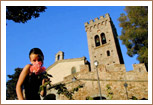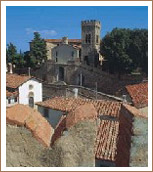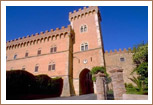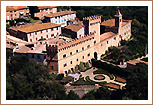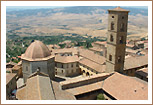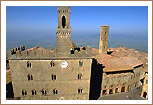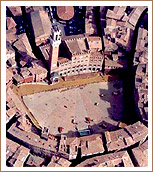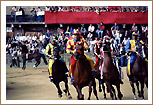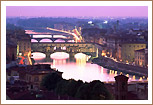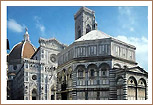| |
|
Borgo alle Mura: our Tuscany
|
| |
|
|
Castagneto Carducci is set on the top of a hill that overlooks
the countryside and the near sea. This charming
Medieval village springs up round the Castle
of Della Gherardesca, built about during the year 1000.
The village has paved lanes, natural terraces that view the sea
and the countryside, pleasant square, ancient craftsman shop and
typical small restaurants. Many historical evidences are worth of
note such as the Praetorian Palace –
now seat of the Municipality –
S. Lorenzo and SS. Crucifix Churches
(the latter because its woody crucifix of the XV century in the
church).
At the beginning this village was named Castagneto Marittimo. Then,
in the early XX c., it turned its name into Castagneto Carducci
in honour of the great poet Giosuè Carducci
that spent there many years of his life. Giosuè Carducci's
house is now a museum full of evidences.
|
| |
|
Bolgheri is located on a little height at the end of the famous
Cypresses Boulevard that stretches from
San Guido. The village is surrounded by woods,
plenty of Mediterranean vegetation and a well-tilled
plain.
Bolgheri is linked to Castagneto, - its borough - through "Via
Bolgherese", a wonderful boulevard become famous as the "Wine
Road" for its production of rare wines. Through a mighty
arch of a castle you will get into the old village. Indoors,
among its ancient lanes and squares, little "shops" spring
up. There you may buy the typical products of the area and taste
the natural local speciality.
|
|
| |
| Between 1838 and 1848 Giosuè
Carducci lived in Bolgheri, chanted it in its lines and this
village became known all over the world. |
| |
|
|
Lonely on a hill (that has its boundless view from
the Appennini up to the Tyrrhenian sea), stern and peaceful at once,
this town has a particular glamour that is different from the others.
Once you reach its threshold, you will be impressed by the mighty
wall, both of the Medieval times and Etruscan ones, where there are
many gates.
The most famous of them is Porta dell'Arco
Etrusco (the gate of Etruscan Arch). Indoors you will find remembrances
of the severe town of Volterra during the Medieval times. All this
is helpful for us to understand the charming of its beauty. |
| |
|
Pisa is set in a wide floodplain (4 m. above sea level) few kilometres
far from the Tyrrhenian coast and it
stretches in the two bank of the river Arno.
Pisa is among the main cultural city of Italy. It keeps a rich artistic
heritage with its original Medieval reworking of Islamic, Lombard
and local influences.
|
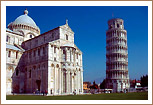 |
| |
It is to note the wonderful Duomo
and the leaning tower, a monument discussed
and known as one of the seven wonders of the world.
It is a chief town of a province of Tuscany and an archiepiscopal
see. Nowadays it is above all a university and
research town. |
| |
| SIENA |
| |
| Siena always attracts many tourists for its
wonderful monuments and its numerous masterpieces to visit
in its museums. Some great artists were
born in Siena and among them it is to remind Duccio di Boninsegna
and Nicola Pisano, who worked on the greatest masterpiece in Siena:
the Duomo. |
| |
|
|
In narrow and winding lanes, in museums and in the quarter oratorios
you may hear Palio propitiatory chants
that recall the ancient customs and modern allegories.
In the evening, on the other side, the patter of soles on the desert
paving contrasts to the peace of the green valleys surrounded by
the walls by its ancient administrators, for centuries till today.
In the town you may admire many masterpieces such as the Duomo,
set in the Campo, Siena's red-bricked main square and the wonderful
landscape of Facciatone, the hall of Pellegrinaio
in Santa Maria della Scala, the Piccolomini
library, the prestigious Accademy Chigiana and the wide rooms
in Fortezza Medicea, that hides the rarest wines in Siena, in Tuscany
and in the peninsula.
|
| |
| FLORENCE |
| |
| Florence stands in a pleasant valley surrounded by
hills and crossed by the river Arno. This
city is rich in monuments, historical buildings, galleries and museums,
expressing all its magnificence of its ancient civilization. |
| |
|
Its world famous promenade along its monuments up to the wonderful
Ponte Vecchio (Old Bridge) is lined
with characteristic goldsmith's shops.
Many are the monuments and the masterpieces to visit, such as Giotto's
Tower begun by Giotto in 1334, the Pitti Palace begun from
an original design by Brunelleschi in the second half of 1400, the
courtyard of Ammannati, Buonarroti house
which has some paintings of Michelangelo, Forte
di Belvedere that dates from the end of 1500. The Uffizi
Palace begun by Vasari in 1560, Loggia
della Signoria begun in1376 from an original design by Arcagno
and Palazzo Vecchio built between 1293
and 1314.
|
|
| |
|
|







